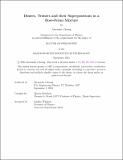Dimers, Trimers and their Superpositions in a Bose-Fermi Mixture
Author(s)
Chuang, Alexander
DownloadThesis PDF (13.45Mb)
Advisor
Zwierlein, Martin
Terms of use
Metadata
Show full item recordAbstract
This thesis describes experiments on few- and many-body bound states in a Bose-Fermi
mixture of ultracold 23Na and 40K atoms. We examine the formation of dimers and trimers in
a balanced, thermal mixture and their evolution into strongly interacting Bose polarons with
hybridized dimer and trimer character when we instead immerse an impurity concentration
of K into a dense quantum bath of Na.
We report a novel direct observation of a heteronuclear halo trimer, consisting of two
lighter Na atoms and one heavier K atom, alongside the familiar NaK Feshbach dimer, using
radiofrequency (rf) spectroscopy. We find that in proximity to a Feshbach resonance, the
trimer feature closely follows the dimer resonance across an order-of-magnitude variation
in binding energy. We show that the measured binding energies are consistent with our
theoretical model of the trimer as having the structure of a Feshbach dimer weakly bound
to one additional boson.
We then study the fate of impurities interacting with a bosonic quantum bath, the
paradigmatic Bose polaron scenario. By preparing an initial attractive polaron state, we
probe previously inaccessible, highly-correlated Bose polaron states, again on the repulsive
side of the Feshbach resonance. Deep within the condensate, the rf spectra no longer exhibit
discrete dimer and trimer features as before, instead dominated by a single broad feature.
We attribute this to the impurity-boson coupling becoming stronger than the dimer-trimer
energy splitting, leading to hybridization of dimer and trimer states and, consequently, an effective level repulsion consistent with the spectra we observe. This experiment demonstrates
the remarkable interplay between polaron physics and bound-state formation in a quantum
environment.
Date issued
2024-09Department
Massachusetts Institute of Technology. Department of PhysicsPublisher
Massachusetts Institute of Technology